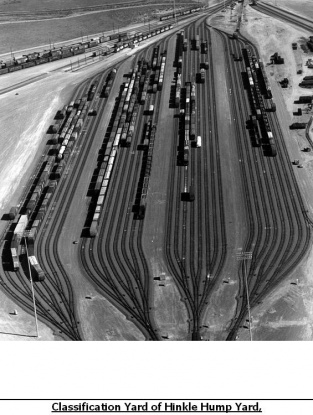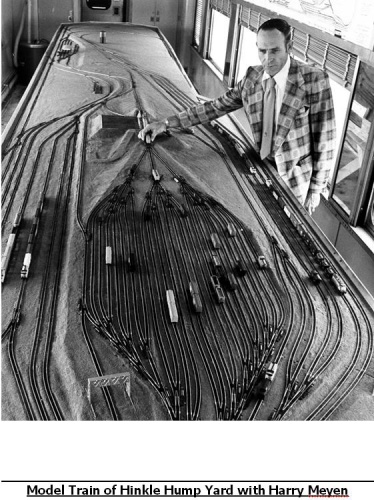Construction of Hinkle Hump Yard and the Model Train Used to Simulate Operations

Terminal Planning and Design Group: Bob Pashek, Jim Conway, John Kenefick, Harry Meyen, Merrill Anderson & Gary Luenenborg
Story of Hinkle, Ore., Hump Yard Process
When developing a plan to replace the existing Flat Switching Yard in Hinkle, Ore., President John Kenefick and other operating personnel were concerned about getting the new Hump Yard built, and because none of the employees at Hinkle had ever worked in a Hump Yard, there was concern the employees would not know how to use it.
After several discussions on the issue, Kenefick asked if it would be possible to build a Model Train Yard duplicate of our plans for Hinkle. I told him we would check it out, and then in researching for those who build model trains in museums, we found someone to do it. Arrangements were made to utilize a passenger car that was stripped clean, and then we measured the area for building the Model Hump Yard and created a design plan for the Hinkle Hump Yard in the designated area.

After they built the table to hold the Designed Yard, we took our plans over to the rail car and drew the plans where all the tracks were to be built. Then we turned it over to the Contracted Model Train contractor to build the plans so they would operate the same way the yard would operate. We closely monitored construction and set it up so the builders could have several people in at a time to give demonstrations on how the yard was to operate. It was very nice looking when it was finished and it was moved to Hinkle where they could give all employees a demonstration how the new Hump Yard was going to work. I am sure it made it easier for the employees to transfer operations to the new Hump Yard. When they were through with the model in Hinkle, it was shipped back to Omaha and the model was modified to look like North Platte Westbound, and they did it all over again.

Since I had a connection at the University of Nebraska-Lincoln where I had been giving speeches on railroad design and operation, I asked the professor I knew if the school would like the Model Hump Yard. He said yes, so it was donated to the University.
The ironic part of this story is that when they were ready to operate the new yard, Tom Simon, who had years of experience operating the North Platte Hump Yard, was transferred to run the new Hinkle Hump Yard, which made the revision a lot easier and Tom was able speed up the process of educating the existing employees.
Merrill J Anderson
Manager of Terminal Planning and Design (at this time)
